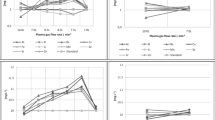Abstract
A direct sampling method by inductively coupled plasma optical emission spectrometry was evaluated for determining trace elements (Co, Cr, Cu, Fe, Mg, Mn, Se and Zn) in Chinese rice wine. The parameters of ICP (plasma power, nebulizer pressure and sampling speed) were optimized considering the complicated matrix. Both the nebulizer pressure and the sampling speed were kept low, and plasma power was set at a high value of 1.35 kW. The good accuracy was confirmed by the recovery test (>95 %). The relative standard deviation was less than 5 %. Comparing with the dry ashing and wet ashing method, direct sampling showed to be fast, reliable and simple. The data of trace metals in Chinese rice wine were obtained: Co (0.088–0.106 mg/L), Cr (0.097–0.164 mg/L), Cu (0.085–0.126 mg/L), Fe (0.181–0.308 mg/L), Mg (0.179–0.311 mg/L), Mn (0.102–0.184 mg/L), Se (0.219–0.349) mg/L), and Zn (0.090–0.139 mg/L).


Similar content being viewed by others
References
Karak T, Bhagat RM (2010) Trace elements in tea leaves, made tea and tea infusion: a review. Food Res Int 43(9):2234–2252
Halliwell B (1996) Antioxidants in human health and disease. Annu Rev Nutr 16:33–50
Gallego MAG, García-Carpintero EG, Sánchez-Palomo E, Viñas MAG, Hermosín-Gutiérrez I (2012) Effect of co-winemaking in phenolic composition, color and antioxidant capacity of young red wines from La Mancha region. Eur Food Res Technol 235:155–167
Oliveira CM, Ferreira ACS, De Freitas V, Silva AMS (2011) Oxidation mechanisms occurring in wines. Food Res Int 44(5):1115–1126
Mayer H, Marconi O, Floridi S, Montanari L, Fantozzi P (2003) Determination of Cu(II) in beer by derivative potentiometric stripping analysis. J I Brewing 109:332–336
Esparza I, Santamaria C, Garcia-Mina JM, Fernandez JM (2007) Complexing capacity profiles of naturally occurring ligands in Tempranillo wines for Cu and Zn: an electroanalytical approach for cupric casse. Anal Chim Acta 599:67–75
Ibanez JG, Carreon-Alvarez A, Barcena-Soto M, Casillas N (2008) Metals in alcoholic beverages: a review of sources, effects, concentrations, removal, speciation, and analysis. J Food Compos Anal 21:672–683
Benítez P, Castro R, Antonio Sanchez PJ, Barroso CG (2002) Influence of metallic content of fino sherry wine on its susceptibility to browning. Food Res Int 35(8):785–791
Blanco CA, Sancho D, Caballero I (2010) Aluminium content in beers and silicon sequestering effects. Food Res Int 43(10):2432–2436
Pohl P (2007) What do metals tell us about wine? Trac-Trend Anal Chem 26:941–949
Koplik R, Linkova M, Mestek O (2011) Changes of phosphorus and trace elements species in rye and oat flakes and oat porridge induced by simulated digestion. Eur Food Res Technol 232:1007–1016
Jos A, Moreno I, Gonzalez AG, Lopez-Artiguez M, Camean AM (2004) Study of the mineral profile of Catalonian “brut” cava using atomic spectrometric methods. Eur Food Res Technol 218:448–451
Thiel G, Danzer K (1997) Direct analysis of mineral components in wine by inductively coupled plasma optical emission spectrometry (ICP–OES). Anal Bioanal Chem 357:553–557
Que F, Mao LC, Pan X (2006) Antioxidant activities of five Chinese rice wines and the involvement of phenolic compounds. Food Res Int 39:581–587
Moreno IM, Gonzalez-Weller D, Gutierrez V, Marino M, Camean AM, GonzAlez AG et al (2008) Determination of Al, Ba, Ca, Cu, Fe, K, Mg, Mn, Na, Sr and Zn in red wine samples by inductively coupled plasma optical emission spectroscopy: evaluation of preliminary sample treatments. Microchem J 88:56–61
Riganakos KA, Veltsistas PG (2003) Comparative spectrophotometric determination of the total iron content in various white and red Greek wines. Food Chem 82:637–643
Richter EM, Augelli MA, Margarotto S, Angnes L (2001) Compact disks, a new source for gold electrodes. Application to the quantitation of copper by PSA. Electroanal 13:760–764
Fraga CG (2005) Relevance, essentiality and toxicity of trace elements in human health. Mol Aspects Med 26:235–244
Lendinez E, Lopez MC, Cabrera C, Lorenzo ML (1998) Determination of chromium in wine and other alcoholic beverages consumed in Spain by electrothermal atomic absorption spectrometry. J AOAC Int 81:1043–1047
Ponka P, Tenenbein M, Eaton JW (2007) Iron. In: Nordberg GF, Fowler BA, Nordberg M, Friberg LT (eds) Handbook on the toxicology of metals. Academic Press, New York, pp 577–598
Acknowledgments
We are thankful to the Institute of Nutrition and Food Security, Chinese Center for Disease Control and Prevention for the technical advice.
Conflict of interest
The authors declare that there is no conflict of interest.
Author information
Authors and Affiliations
Corresponding authors
Rights and permissions
About this article
Cite this article
Pan, XD., Tang, J., Chen, Q. et al. Evaluation of direct sampling method for trace elements analysis in Chinese rice wine by ICP–OES. Eur Food Res Technol 236, 531–535 (2013). https://doi.org/10.1007/s00217-012-1888-3
Received:
Revised:
Accepted:
Published:
Issue Date:
DOI: https://doi.org/10.1007/s00217-012-1888-3




